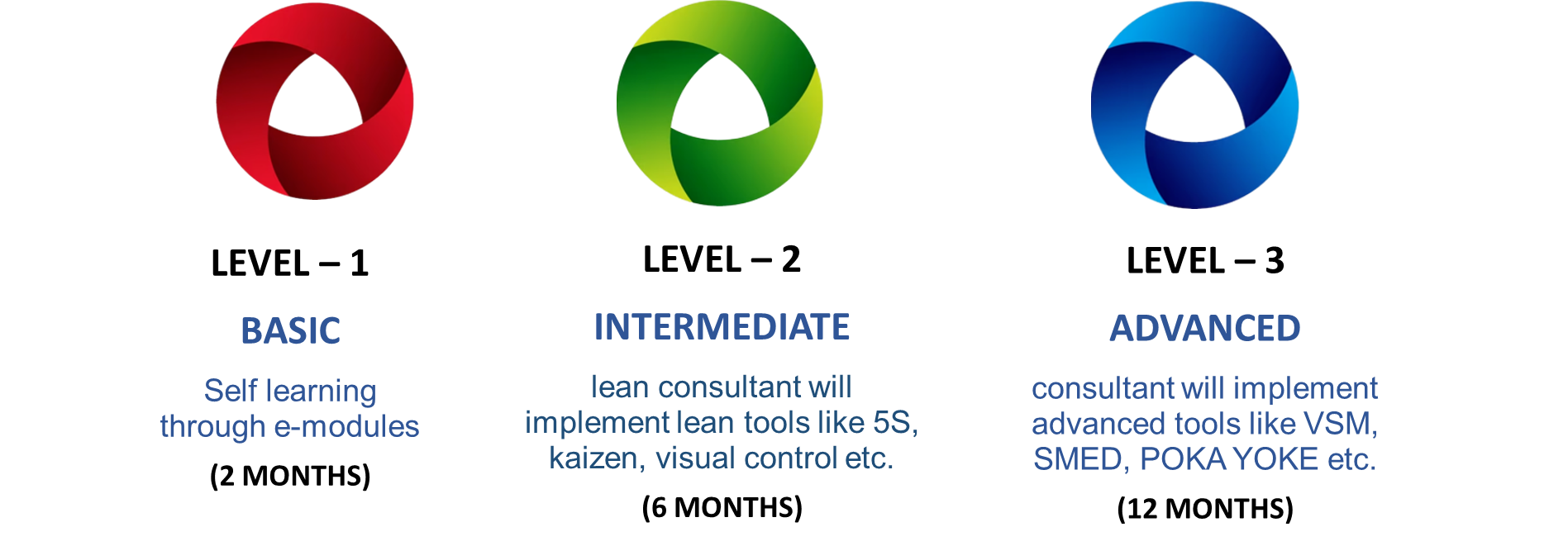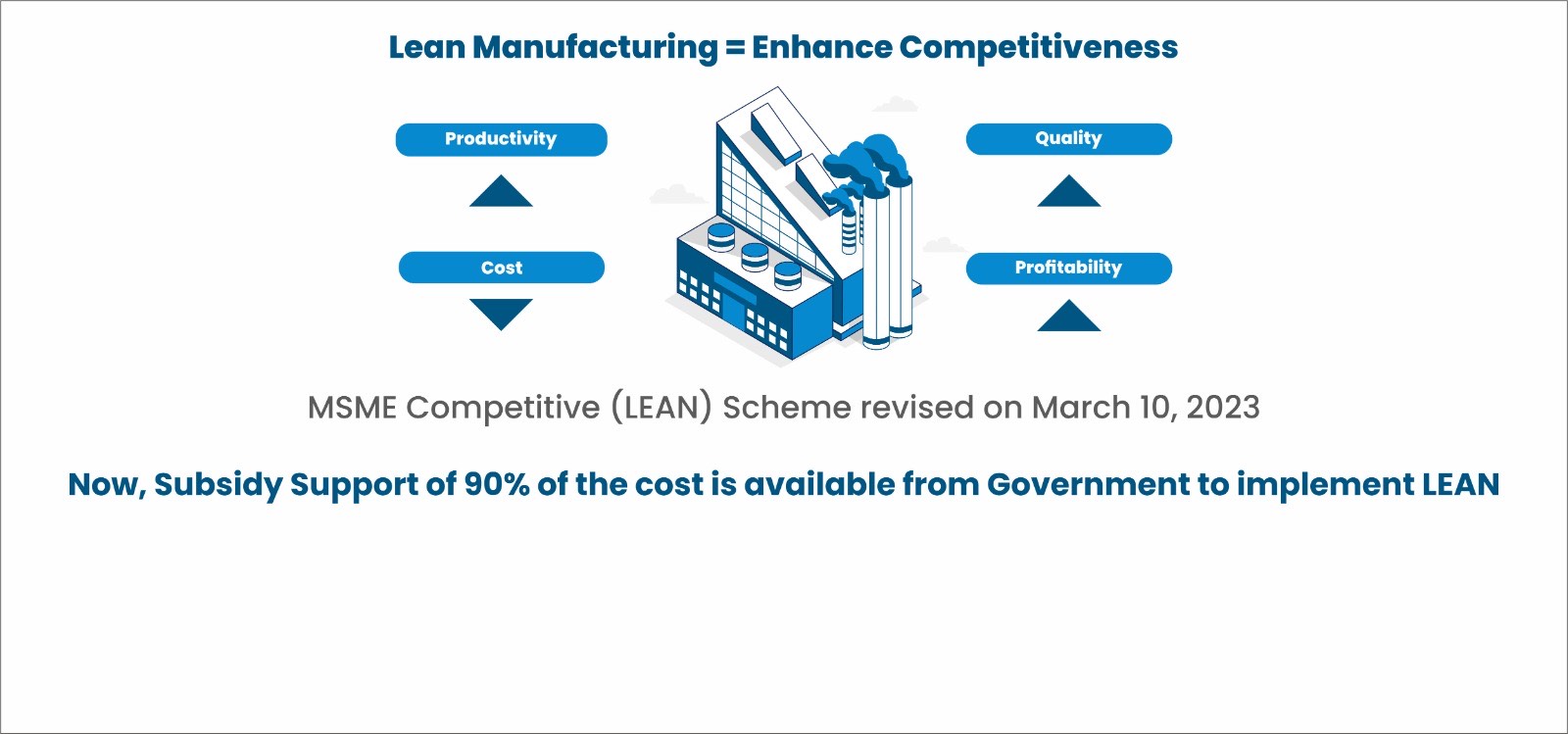LEAN Manufacturing
LEAN Manufacturing
Government of India has launched a revised version of the MSME Competitive (LEAN) Scheme on March 10, 2023 to aid micro, small, and medium-sized companies to improve their global competitiveness by utilizing LEAN manufacturing tools with the guidance of trained LEAN consultants. The scheme aims to reduce waste, optimize resources, and enhance various aspects of MSME operations. Eligible MSMEs will receive financial assistance and graded incentives. A single-window digital platform will be used to support the scheme’s execution.
Scheme is revised for more benefits to enterprises and stakeholders. Under the revamped scheme, the Centre's contribution will be 90% of the implementation cost for handholding and consultancy fees as against 80 % previously.
Micro Small and Medium Enterprises Secretary B B Swain said the revamped scheme is being introduced in two phases. The first phase will cover the manufacturing sector while the services sector will be covered in the second phase.
All you need to know about the Lean Management & MSME Competitive (LEAN) Scheme
What is Lean Management?
Lean Management is a systematic approach to managing and improving business processes by eliminating or reducing waste and increasing efficiency. It involves delivering value to customers while minimizing non-value-added activities, standardizing processes, and empowering employees to identify and solve problems. Lean Management principles are widely applied in various industries and organizations worldwide.
Lean Management approach works on below principles:
- Value: Defining value adding activities in a business and manufacturing process from the perspective of the customer requirement is the first step in the Lean process. Value added activities is in a business and manufacturing process is
- The activity that the customer is willing to pay for,
- The activity that material must change its size, shape or property in the direction of customer requirements.
- The activity that must be done right the first time.

- Value Stream: Mapping out the value stream (or all the steps involved in producing and delivering a product or service) is the most important step to identify the value added and non-value added activities.
- Flow: Once the value stream has been mapped out, the focus turns to improving the flow of materials and information through the system, to reduce wastes (Non-value added activities). Below are the 8 types of wastes we should observe and reduce in value stream.
- Defect: Errors or mistakes that result in rework, waste, and loss of time, money, and reputation.
- Over production: Producing more than what is required or before it is needed, resulting in excess inventory, over processing, and waiting times.
- Waiting: Delays or downtime that result in wasted time and resources, such as waiting for materials, equipment, or people.
- Non-utilized Talent: Failing to utilize the knowledge, skills, and creativity of employees, resulting in reduced engagement, motivation, and productivity.
- Transportation: Unnecessary movement of materials or goods, resulting in increased costs, risks, and lead times.
- Inventory: Excess inventory that is not being used or needed, resulting in additional storage costs, risk of obsolescence, and reduced cash flow.
- Motion: Unnecessary movement of people or equipment, resulting in fatigue, injury, and wasted time. Ultimately people fail to add value in process.
- Extra processing: Performing unnecessary or non-value added activities in the production process, such as rework or over-engineering.
- Pull: The aim of Lean is to produce goods and services only when they are needed, in response to customer demand, rather than building up inventory.
- Perfection: Improvement is never ending process. Continuous improvement is a key principle of Lean, with the goal of striving for perfection in all aspects of the organization. A process called perfect when there is 100% value added activities are being performed in organization.
- Respect for People: Lean is a people-centered approach, which emphasizes the importance of empowering and engaging employees in the improvement process.
- Everyone, Every day, Everywhere: Lean is not a program or initiative, but a way of thinking and working that can transform the entire organization when embraced by everyone, every day, and everywhere.
- "Everyone" - every employee, from the “Doorman” to the “Chairman” has a role to identify and reduce waste in process.
- "Everyday" - Lean is not a one-time event or project, but a daily practice that involves continuously identifying and addressing inefficiencies and opportunities for improvement.
- "Everywhere" - Lean is not limited to one area or department / function of the organization, but rather extends across the entire value stream, from suppliers to customers (Involves all functions such as Sales and Marketing, Purchase, Stores, Design, Production, Stores, Finance, HR etc.)
Why an organization should implement Lean Management?
In today's highly competitive business environment, implementing Lean Management can provide several advantages to an organization. Here are some of the reasons why an organization should consider implementing Lean Management:
- Increased Efficiency: Lean Management helps organizations to become more efficient by reducing waste and optimizing processes. This can lead to faster turnaround times, reduced costs, and increased productivity, all of which can provide a competitive advantage in the marketplace.
- Improved Quality: Lean Management emphasizes the importance of continuous improvement and defect prevention. By focusing on quality, organizations can reduce errors and defects, leading to increased customer satisfaction and a better reputation in the market.
- Enhanced Customer Value: Lean Management focuses on identifying and delivering what customers truly value. By doing so, organizations can create products and services that better meet customer needs, which can lead to increased customer loyalty and a stronger competitive position.
- Empowered Employees: Lean Management involves everyone in the organization and empowers employees to identify and solve problems. This can lead to a culture of continuous improvement, where employees are encouraged to take ownership of their work and make meaningful contributions to the organization's success.
- Competitive Advantage: Organizations that implement Lean Management are often more competitive because they can deliver products and services faster, with higher quality and lower costs. This can lead to increased market share and profitability, as well as a stronger overall position in the market.
How Lean Management can be implemented?
Lean Management can be easily implemented using PDCA cycle.
The PDCA (Plan-Do-Check-Act) cycle is a continuous improvement model that can be used to implement Lean Management in an organization. Here is how the PDCA cycle can be applied to Lean Implementation:
- Plan: The first step in implementing Lean Management through the PDCA cycle is to plan. This involves identifying the value stream, analyzing it for areas of improvement, and setting goals for process improvement. This step also involves identifying the tools and techniques that will be used to implement Lean Management.
- Do: The second step is to do or implement the plan. This involves implementing the Lean tools and techniques identified in the planning phase. It is important to involve all employees in this phase to ensure that everyone is on board with the changes being made.
- Check: The third step is to check or measure the results of the Lean implementation. This involves collecting data on process efficiency, quality, lead times, and other metrics to determine if the implementation is achieving the desired results.
- Act: The final step in the PDCA cycle is to act on the results of the check phase. This involves making adjustments and improvements to the Lean implementation based on the data collected in the check phase. It is important to continue this cycle of continuous improvement to ensure that the Lean implementation is successful.
By using the PDCA cycle to implement Lean Management, organizations can create a culture of continuous improvement and empower employees to identify and solve problems. This approach can help organizations to become more efficient, improve quality, enhance customer value, and gain a competitive advantage in the marketplace.
External Supports organization can avail to implement Lean Management
- Directly from Lean Management Consulting Firms: There are numerous consulting firms in India that specialize in Lean Management and can provide guidance and support for organizations looking to implement Lean Management.
- Government Programs: The Indian government offers the MSME Competitive (Lean) Scheme.
MSME Competitive (Lean) Scheme by Central Government of India:
Objective of the Scheme:
|
Reduction In
|
Optimization Of
|
Enhancement Of
|
Eligibility:
- All MSMEs registered with the UDYAM registration portal (of the MoMSME) will be eligible to participate in MSME Competitive (Lean) Scheme and avail related benefits/incentives.
- Scheme is also open to Common Facilities Centres (CFCs) under SFURTI (Scheme of Fund for Regeneration of Traditional Industries) and Micro & Small Enterprises - Cluster Development Program (MSE-CDP) Schemes.
Scheme Levels:
MSME Competitive (Lean) Scheme can be attained in THREE Levels after registering and taking the Lean Pledge:

a) Every MSME that embarks on the journey of Lean (Basic, Intermediate, Advanced) will have to take a “Lean Pledge” before undertaking the journey of implementation of lean tools and techniques.
b) The intent of taking a Lean Pledge is to take a “pre-commitment” or a solemn promise by MSMEs to uphold the values of Lean Practices and Philosophy in their functioning and to urge them to move ahead on the journey of Lean.
c) After taking the Lean Pledge, the MSME can apply for handholding of its units depending on the need and level of preparedness and interest of MSME unit. Lean Scheme can be implemented by MSME units in the above three levels.
Financial Assistance
- 90% subsidy on implementation cost of consultant fees for the MSMEs.
- Additional 5% contribution shall be given to the MSMEs registering through industry association/ OEM after completion of all levels.
- € 5000/per MSME shall be given to OEM/ association after completing all stages of lean intervention.
MSME can approach below government implementation bodies to avail benefit of this scheme.
- NPC (National Productivity Council) http://www.npcindia.gov.in/
- QCI (Quality Council of India) http://www.qcin.org/
For more details, visit official website of MSME Competitive (Lean) Scheme https://lean.msme.gov.in/
Conclusion
In today’s competitive market, Lean Management is a powerful and effective approach to managing and improving business processes. By focusing on reducing waste, optimizing processes, and empowering employees, organizations can achieve significant benefits, such as increased efficiency, improved quality, enhanced customer value, and a competitive advantage. Lean Management principles can be applied to any industry and organization, and can be easily implemented using the PDCA cycle. It is essential for organizations to embrace the Lean Management approach as a way of thinking and working, involving everyone, every day, and everywhere, to create a culture of continuous improvement and drive success.
And why not to implement when Subsidy Support of 90% of the cost is available from Government???



